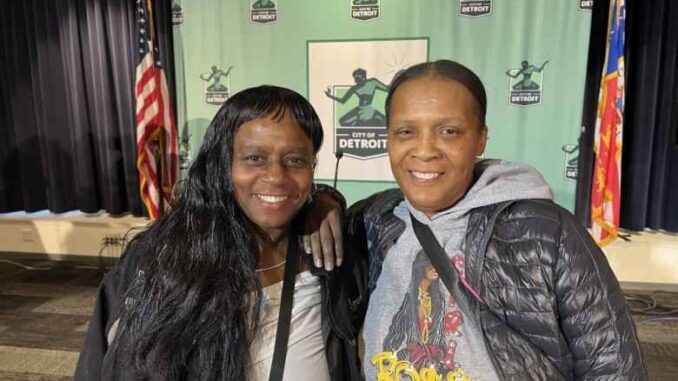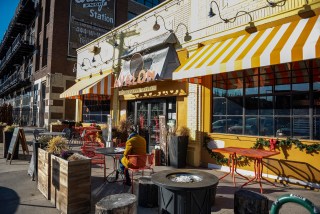
This article originally appeared on Planet Detroit.
After Mayor Mike Duggan announced nine finalists in his campaign to recruit Detroit neighborhoods to host solar panel arrays at a Wednesday press conference, community members and activists are divided over whether the plan will help or unfairly burden their communities.
“I thought it was time the city of Detroit stepped up and took action on climate change,” Duggan said. “Too much of the climate change discussion in this country, as far as I’m concerned, is empty performance.”
Under the program, owner-occupied households in selected communities would be eligible to receive $10,000 to $25,000 in energy-efficient upgrades, such as new windows, roofs, energy-efficient appliances, or battery back-up for power outages.
Detroit would own the land for the solar arrays and contract with private solar developers to build and operate them. Details for how the city would be credited for the power are not yet determined, Duggan said.
Of the nine, he said six will be selected to assemble 250 acres of vacant and underutilized land to offset the electricity used to power city operations. Duggan said the project will cost the city about $8 million a year, or roughly what Detroit now pays DTE Energy to power the city’s 127 public buildings, plus $1-2 million per year more to provide community benefits. He said he plans to bring a funding proposal to city council by spring.
The finalist neighborhoods includeGratiot/Findlay, Greenfield Park/I-75 McNichols, Grixdale, Houston Whittier/Hayes, I-96/Plymouth (O’Shea), Mount Olivet, State Fair, Trinity Pickford and Van Dyke/Lynch.
Duggan emphasized that the city would place solar arrays only in areas “where we are wanted,” noting that the city would buy out residents in owner-occupied homes with a minimum offer of $90,000 and would pay moving costs and 18 months’ rent for tenants. He previously said the city sought “stretches where they don’t have more than one or two occupied homes.”
But several proposals contain a number of residences, especially rentals.
For example, the footprint of the 21-acre Mt Olivet project contains 16 renter-occupied and seven owner-occupied homes. Duggan said the fenced-in solar panel arrays would contribute to neighborhood stability and prevent illegal dumping in vacant and abandoned areas of the city.
But Duggan spokesperson John Roach said the city could also use eminent domain to assemble land for the arrays, and the mayor said the city may condemn vacant properties owned by speculators. The finalist neighborhoods have until Jan. 31 to provide documentation that residents in owner-occupied homes are willing to move.
Measha Parker has lived in Gratiot-Findlay for 18 years. She’s president of her block and said she hoped the fenced-in panels on 24 acres would help fight illegal dumping and drive out illegal drugs in the area.
She’d also like to see the former Wilkins Elementary School building, which has sat vacant for years, demolished as part of the plan. But she is concerned about vandalism and hopes the solar arrays will have surveillance cameras.
“It’ll bring safety over there,” she said. “Once they put the solar panels up…. It’ll help with the blight and help the whole area survive.”
Block club captains in the Gratiot-Findlay area. Left to right: Donna Anthony, Measha Parker.
But several residents and sustainability advocates Planet Detroit talked to question the emphasis on large solar arrays that won’t provide energy directly to residents. Others voiced concern that the projects could attract even more blight.
Birch Kemp, a lifelong Detroiter and president of the nonprofit tree-planting organization Arboretum Detroit, said he supports installing solar panels on top of buildings but worries that fenced-in solar fields will only add to blight problems and hurt property values.
Kemp said city officials approached him and others living in and around the Poletown East area about a possible array around Perrien Park, a former Detroit Public Schools site, but neighborhood organizations unanimously rejected it.
“It’s not going to increase anybody’s property value. It’s not going to make it look more beautiful. And it’s not going to increase your access to green space,” he said. “It’s going to be like a little prison for solar panels.”
A recent study found solar installations in California, Connecticut, New Jersey, Minnesota, and Massachusetts reduced property values by 1.5% within half a mile, and outcomes varied by state.
Kemp added that the solar fields would tie up land the city could use for open space and green infrastructure to sequester stormwater and prevent basement flooding. He also worries that trees would need to be cut down to reduce shade on the panels.
Experts consider tree cover important for reducing heat and managing stormwater. And while solar power is considered critical for dealing with the climate crisis, solar fields can create a localized increase in temperature.
This may pose a special problem in Detroit, where the heat island effect, or the capacity of impervious surfaces to absorb and re-emit heat, already increases temperatures by 8 degrees or more.
Jon Kent, a Riverbend resident and co-founder of Sanctuary Farms, also supports solar, but said communities hosting the arrays should benefit more than what he sees in the current proposal.
“They’re doing this within neighborhoods that are really poor and really disengaged,” he said, adding that these areas would be getting a one-time pay-out while the city would continue to benefit.
Kent said he’d like to see the city take more time with the process, doing additional community outreach and building in a more extensive community benefits process that could include allowing communities to renegotiate the terms for hosting arrays in the future.
The expedited time frame may be driven by pressure to secure federal support through the Inflation Reduction Act before this program ends in 2033. A city of Detroit spokesperson confirmed that the city is seeking federal credits to offset municipal operations’ energy use under the IRA. However, they added that the short timeline is because “the mayor feels the climate crisis is an urgent matter.”
Roach defended the current plan, saying the city worked with 15 renewable energy groups to develop the proposal and that eight groups, including Walker-Miller Energy Services, EcoWorks and the GreenDoor Initiative, have been working with neighborhoods to help them develop community benefit requests.
“This is a remarkable partnership between renewable energy advocates and neighborhood groups to design better neighborhoods that will help fight climate change,” he said.
Roach also pushed back on the idea that solar could hurt property values. “Those who best know the property values in a neighborhood are those who actually live there, which is why they will be the ones choosing the sites,” he said.
Jackson Koeppel, a Highland Park-based energy democracy practitioner and former executive director of the nonprofit Soulardarity, questioned the strategy of jumping immediately to large-scale solar arrays before embracing more targeted strategies.
“This approach to just build out as much solar on vacant land as possible to meet that need isn’t the right order of operations,” he said. Koeppel argues that on-site and rooftop solar and battery storage is the most cost-effective approach for city operations because it would generate “behind the meter” power that would allow the city to avoid the full cost of energy it would otherwise have to purchase.
Instead, the mayor’s proposal would have a third-party solar developer generate the power and likely sell it to DTE, which could then credit the city on its bills. The city’s request for information from solar developers did include inquiries about behind-the-meter projects at municipal facilities.
North Rosedale resident Amanda Paige said the city could incorporate solar energy into the urban landscape in other ways, like installing rooftop solar panels in neighborhoods or putting panels on top of structures like parking garages and bus shelters.
She worries especially about those living in some of Detroit’s most disinvested neighborhoods who may be underwater on their mortgages and struggling to build generational wealth.
“They’re not attractive,” Paige said of solar panels. “It’s not going to do anything for your long-term property values if you’re across the street from a big solar farm.”



